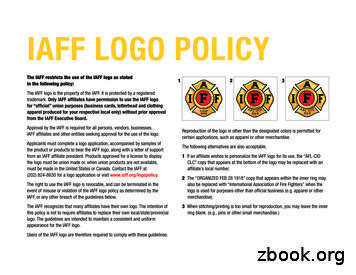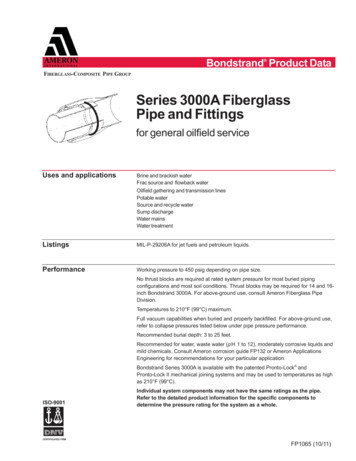Logo On White, Gray Or Any Lighter . - The Home Channel
Logo on white, grayor any lighter shadewhen printing colorRRPROJECT PLANSLogo on Pantone2945 or any darkershade when printingcolorOUTDOOR SERVING CARTLogo on whiteor light shade whenprinting grayscaleRRMake outdoor entertaining easy with this serving cart. It offers lots of spacefor storing food, tableware, and outdoor supplies, plus it cradles bottleswhere they’re easy to reach but protected from spills. The top “shelf” is alift-off tray, so you can carry supplies from the cart to your table.Logo on black ordark shade whenprinting grayscaleThe entire cart is built from pine 1x2 and 2x2 boards. Pine might not be thefirst wood you think of for outdoor use. We chose pine because the bettergrades look great, and tend to be crisper and straighter than similarly sizedcedar boards. Just add a good-quality finish, and don't leave the cart sittingout in the weather for months on end, and it will serve you well for years.
Safety:Attention: Almost any do-it-yourself project involves risk of some sort. Your tools, materials, and skills willvary, as will the conditions at your project site. Kreg Tool Company (“Kreg”) has made every effort to becomplete and accurate in the instructions and other content contained in this document. However, Kreg willnot assume any responsibility or liability for damages or losses sustained or incurred in the course of yourproject or in the use of the item you create. Always follow the manufacturer’s operating instructions in the useof tools, check and follow your local building codes, and observe all commonly accepted safety precautions.We strive to be accurate, but reserve the right to correct any errors.Materials:Qty DescriptionQty Description(8) 1x2 x 96" pine boards(1) 3/8"-16 x 36" threaded rod(1) 1x2 x 48" pine board(2) 3/8"-16 acorn cap nut(4) 2x2 x 96" pine boards(1) 3/8"-16 standard nut (optional)(1) 2x2 x 72" pine board(4) 1/2" Fender Washer(140) 1 1/4" exterior pocket hole screws (2) 12" Steel Wheel(76) 2 1/2" exterior pocket hole screws wood glue(1) 1/2" x 36" Aluminum Round Rod clamps(1) 1/2" x 36" Aluminum Tubingwood finish(3/8" or greater inside diameter)Tools:Drill/DriverKreg Jig Miter SawHacksawTape MeasureSandpaper and SanderSquareOptional Tools:Kreg Square-Cut Logo on white, grayor any lighter shadewhen printing colorLogo on Pantone2945 or any darkershade when printingcolor2Kreg Project Plans: Patio Serving Cart 2016 Kreg Tool Company. All Rights Reserved.Logo on whiteor light shade whenprinting grayscale
Cutting Diagram:Logo on white, grayor any lighter shadewhen printing colorLogo on Pantone2945 or any darkershade when printingcolor3Kreg Project Plans: Patio Serving Cart 2016 Kreg Tool Company. All Rights Reserved.Logo on whiteor light shade whenprinting grayscale
Step 1: Cut 24 Shelf Slats from 1x2 pine boards as shown in thecutting diagram. Set your pocket hole jig for 3/4" thick material, andthen drill pocket holes in all of the Slats where shown.Step 2: Cut 4 Side Rails from 2x2 pine, as shown in thecutting diagram. Set your pocket hole jig for 1 1/2" thickmaterial and drill pocket holes on the Side Rails where shown.Step 3: On a flat work surface, lay two Shelf Rails parallel to one another with the pocket holes facing up. Positionthe first Shelf Slats perpendicular to the Shelf Rail and inset3/4" from the edge. Secure the Slat to the Rail with 1 1/4"coarse-thread pocket hole screws. Space the next Slat 3/4"away and screw it in place. Secure the rest of the slats toone rail the same way. Use the same process for the secondRail as well as the second Shelf.Logo on white, grayor any lighter shadewhen printing colorLogo on Pantone2945 or any darkershade when printingcolor4Kreg Project Plans: Patio Serving Cart 2016 Kreg Tool Company. All Rights Reserved.Logo on whiteor light shade whenprinting grayscale
Step 4: Cut two Front Legs and two Back Legs to length from2x2 boards, as shown in the cutting diagram. Set your pockethole jig for 1 1/2" thick material and drill a single set of pocketholes on one end of the Front and Back Legs as shown.Step 5: Place the two Back Legs together with the pocketholes face to face and temporarily tape the Back Legstogether with painters tape. Mark the location of the 1/2"hole, and then drill through both Back Legs as shown.Step 6: Cut two Hand Rails to length form 2x2 pine boards,as shown in the cutting diagram. Tape the two Hand Railstogether with painters tape, mark the location of the 1/2" hole,then drill through both Rails as shown.Step 7: Attach the Front and Back Legs toone Hand Rail with 2 1/2" coarse-thread pockethole screws at the location shown. Complete thesame operation for the other Legs and Hand Railto create two leg assemblies.Logo on white, grayor any lighter shadewhen printing colorLogo on Pantone2945 or any darkershade when printingcolor5Kreg Project Plans: Patio Serving Cart 2016 Kreg Tool Company. All Rights Reserved.Logo on whiteor light shade whenprinting grayscale
Step 8: Cut seven End Rails to length form 2x2 pine boards asshown in the cutting diagram. Set your pocket hole jig for 1 1/2"material, and then drill pocket holes in both ends of each Rail.Step 9: Secure the seven End Rails to one LegAssembly with 2 1/2" coarse-thread pocket holescrews at the locations shown.Step 10: Add the uppershelf assembly, and thenthe lower shelf assembly,to the leg assembly using2 1/2" coarse-threadpocket hole screwsas shown.Logo on white, grayor any lighter shadewhen printing colorLogo on Pantone2945 or any darkershade when printingcolor6Kreg Project Plans: Patio Serving Cart 2016 Kreg Tool Company. All Rights Reserved.Logo on whiteor light shade whenprinting grayscale
Step 11: Now add the second leg assemblyand secure it with 2 1/2" coarse-thread pockethole screws to complete the cart frame.Step 12: Cut two TraySupports, Two BottleSupport Bottoms and fourBottle Support Sides from1x2 boards. Set your jigfor 3/4" material and drillpocket holes in the BottleSupport Bottoms and theTray Supports as shown.Step 13: Secure the Bottle SupportSides to the Bottle Support Bottomswith 1 1/4" coarse-thread pocket holescrews as shown.Logo on white, grayor any lighter shadewhen printing colorLogo on Pantone2945 or any darkershade when printingcolor7Kreg Project Plans: Patio Serving Cart 2016 Kreg Tool Company. All Rights Reserved.Logo on whiteor light shade whenprinting grayscale
Step 14: Install the bottle support assemblies whereshown and secure them with glue. Clamp these assembliesin place while the glue sets. Install the Tray supports whereshown using 1 1/4" coarse-thread pocket hole screws.Step 15: From 1x2 boards, cut twoTray Ends, Two Tray Sides and nineTray Slats, as shown in the cuttingdiagram. Drill Pocket holes in bothends in all of the Tray Slats.Step 16: Position the Tray Slatsas shown along one Tray Side,and then attach them using 1 1/4"coarse-thread pocket hole screws.Then attach the second Tray sidethe same way.8Step 17: Whenthe Sides and Slatsare assembled, daba little glue on theends of the TrayEnds, place them inposition, and clampthem in place untilthe glue sets.Logo on white, grayor any lighter shadewhen printing colorLogo on Pantone2945 or any darkershade when printingcolorKreg Project Plans: Patio Serving Cart 2016 Kreg Tool Company. All Rights Reserved.Logo on whiteor light shade whenprinting grayscale
Step 18: Cut seven End Rails to length form 2x2 pine boards as showninUse a hacksaw to cut the Cart Handle from 1/2" aluminum round barStock, the Aluminum Axle from 1/2" aluminum tubing, and the TreadedAxle form 3/8" threaded rod, as shown in the cutting diagram. Sand off anyburs and polish the Handle and the Aluminum Axle with a Scotch Brite pad.Step 19: Install the Handleby sliding it through the holesin Hand Rails. If needed, usea little epoxy to secure theHandle in place.Step 20: Slide the Aluminum Axletube into the holes in the bottomof the Back Legs so they protrudepast the Back Legs equally. Slide afender washer over the each side ofthe tube, then add the wheels. Now,slide the Threaded Axle through theAluminum Axle, and then add theother two fender washers. Finally,add the Cap Screw on each end ofthe Threaded Axle and tighten themso they are just snug.Project Tip: When you cut threadedrod with a hacksaw, the threading onthe cut end can get damaged. A trickto restoring the threading is to screw anut on to the rod before cutting the rod.Spin the nut out of the way of the cut,cut the rod to length, and then screwthe nut off the cut end. This shouldrestore the threading enough to get anut back on the Cut end of the rod.Step 21: Sand the cart smooth and soften any sharp edgeswith sandpaper. Then apply a finish. We used a natural oilto enhance the grain and color of the pine. Because the cartis made of pine, you probably want to park it indoors, or atleast under an overhang, during bad weather. That will helpit last longer. We also spray painted our wheels (which comepainted white), and sprayed on some of the same color on thelower end of each Front Leg.Logo on white, grayor any lighter shadewhen printing colorLogo on Pantone2945 or any darkershade when printingcolor9Kreg Project Plans: Patio Serving Cart 2016 Kreg Tool Company. All Rights Reserved.Logo on whiteor light shade whenprinting grayscale
4 Kreg Project Plans: Patio erving Cart 216 Kreg Tool Company. All ights eserved. Logo on white, gray or any lighter shade when printing color Logo on Pantone 2945 or any darker shade when printing color Logo on white or light shade when printing grayscale Logo
Flat gold and black logo Flat red and black logo Flat black and white logo U.S. and Canada logo In black and white applications, use the flat black and white logo. In one color applications, such as decals, use the flat gold and black logo or flat red and black logo. x is equal to half
the Leave No Trace logo — is not diluted by other insignia or artwork. Logo Variations The logo has three variations in regards to content — basic logo, logo and Center for Outdoor Ethics, logo and Center for Outdoor Ethics and URL — and three variations in regards to color — color, black, white, and gray scale. Logo Sizes
The MRC logo can and should be used with either the housing organization's logo or the local MRC logo. The MRC logo should not be altered in any way to create a new local MRC logo. If an MRC unit has its own logo, it should be used with the MRC logo. The local MRC unit may add its name, city, or county to the MRC logo. However .
LOGO Full color logo: For use on white backgrounds only CAMPAIGN LOGO Knock-out logo: For use on solid campaign color backgrounds (see page 3). Knock out always to be at 100%. Logo never appears transparent. Recommended minimum size MINIMUM SIZE REQUIREMENTS The logo requires one “o” shape of clearspace on all sides LOGO CLEARSPACE
A logo must be attractive. A logo must be working in black and white. A logo must be ready for brand identity. A logo must be suitable. A logo must be flexible. I If you are starting out in graphic design, or have been graphic designing for a while, you must have heard, read and even said that "a logo must be blah blah blah".
The Google for Education Logo Apply these guidelines when using our logo in your collateral. Horizontal logo Stacked logo Google logo in four colors “for Education” modifier Logo is composed of two elements: Google logo in color and the “for Education” modifier. Use artwork as provided—elements cannot be altered in any way.
LOGO USAGE . ONE-COLOR LOGO USAGE TWO-COLOR LOGO USAGE . The one-color logo can be used independently or atop its respective pattern or an appropriate photo. The two-color logo includes an inverted color background to ensure readability. Do not remove the background. 7 . MULTICAM BRAND GUIDE LOGO LOGO MULTICAM BRAND GUIDE 8
Pipe Size ASTM Designation (in) (mm) (D2310) (D2996) 2 - 6 50 - 150 RTRP 11FX RTRP 11FX-5430 8 - 16 200 - 400 RTRP 11FX RTRP 11FX-3210 Fittings 2 to 6-inch Compression-molded fiberglass reinforced epoxy elbows and tees Filament-wound and/or mitered crosses, wyes, laterals and reducers 8 to 16-inch Filament-wound fiberglass reinforced epoxy elbows Filament-wound and/or mitered crosses, wyes .























